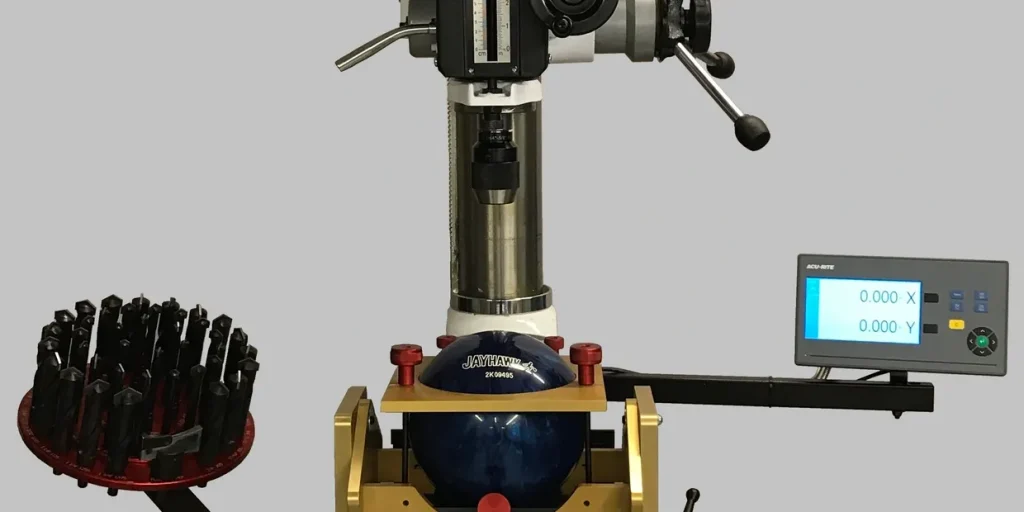Welcome to the comprehensive guide on drilling bowling balls. Whether you’re a seasoned bowler or a beginner, understanding the techniques and importance of drilling your bowling ball is crucial to your success on the lanes. This article will cover the various aspects of drilling bowling balls, including the process, types of drilling layouts, drilling equipment, and much more. Let’s dive in!
Drilling Bowling Ball – The Basics
Before we claw into the nitty- gritty, let’s start with the fundamentals of drilling a bowling ball.
Bowling balls come with a series of holes where you fit your fritters to gain control during the gamble. Drilling a bowling ball is a customization process that involves creating these finger holes according to your specific hand size, shape, and playing style. Proper drilling ensures a comfortable grip, improved accuracy, and better overall performance.
Importance of Proper Drilling Bowling Ball
The way your ball is drilled significantly impacts your game. Here are some key reasons why proper drilling is essential:
1. Improved Performance: Correct drilling optimizes your ball’s motion, allowing it to hook and hit the pins more effectively, resulting in improved performance on the lanes.
2. Comfort and Control: A well-drilled ball offers a comfortable grip, reducing fatigue and enhancing control during your throws.
3. Injury Prevention: Custom drilling minimizes the risk of hand and wrist injuries caused by using ill-fitted equipment.
4. Consistency: With a consistently drilled ball, you can repeat shots more accurately, leading to higher scores.
Choosing the Right Drilling Layout
Selecting the appropriate drilling layout is critical to optimizing your ball’s performance based on your unique bowling style. Here are some popular drilling layouts to consider:
1. Conventional Grip: This classic drilling style features a simple, symmetrical layout with a comfortable grip for beginners and those who prefer a traditional approach.
2. Finger-Tip Grip: The finger-tip grip provides more hook potential and is favored by intermediate to advanced bowlers due to increased rev rate and power.
3. Semi-Finger-Tip Grip: Offering a balance between the conventional and finger-tip grips, this layout caters to those seeking moderate hook potential.
The Drilling Process – Step by Step
Let’s walk through the step-by-step process of drilling a bowling ball:
1. Measurements and Marking: The first step involves measuring your hand’s span, span distance, and pitches to determine the optimal hole placements. Mark the spots with precision.
2. Hole Creation: Using a specialized drilling machine, the holes are carefully drilled into the ball following the marked locations. The depth and angle are vital to achieving the desired ball reaction.
3. Sanding and Finishing: After drilling, the holes are smoothened and finished to eliminate any roughness, ensuring a comfortable grip.
Drilling Equipment – The Must-Haves
To accomplish a successful bowling ball drilling, specific equipment is required. Here’s what you need:
1. Bowling Ball Jig: A jig securely holds the ball in place while drilling and allows precise positioning.
2. Drill Bits: Different drill bits with varying diameters are used for creating finger holes of different sizes.
3. Measuring Tools: Calipers and rulers are essential for accurate measurements and markings.
4. Abrasive Pads: These pads help in smoothing the holes and edges after drilling.
Common Drilling Bowling Ball Techniques
Achieving the right drilling layout involves using different techniques. Here are some popular ones:
1. Pin-to-PAP Distance: This technique determines the distance between the ball’s pin and the Positive Axis Point (PAP) to influence ball motion.
2. Dual-Angle Layouts: Dual-angle layouts consider both the horizontal and vertical angles, resulting in a versatile ball motion.
3. Balance Hole: If your ball is exceeding the weight limits, a balance hole can be added to regain the desired balance.
Frequently Asked Questions (FAQs)
Now, let’s address some common questions about drilling bowling balls:
1. Can I Drill My Bowling Ball Myself?
• It is highly recommended to have your bowling ball drilled by a professional to ensure precision and avoid damage.
2. How Much Does Drilling a Bowling Ball Cost?
• The cost of drilling a bowling ball typically ranges from $30 to $60, depending on the complexity of the layout and the pro shop’s rates.
3. Can I Change the Drilling Layout of My Bowling Ball?
• Yes, you can alter the drilling layout to adapt to changes in your bowling style or lane conditions.
4. Should I Plug and Redrill My Ball?
• Plugging and redrilling your ball may be necessary if your hand size or playing style changes significantly.
5. What’s the Average Time for Drilling a Bowling Ball?
• On average, the drilling process takes around 30 minutes to an hour, depending on the complexity.
6. Do Pro Shops Offer Custom Drilling Options?
• Yes, most pro shops offer custom drilling to match your specific needs and preferences.
Conclusion
Mastering the art of drilling bowling balls is a game-changer for bowlers of all levels. Customizing your ball’s grip and layout can significantly enhance your performance and boost your confidence on the lanes. Remember to seek professional help during the drilling process, and always choose the right layout to match your playing style. Happy bowling!

